As a plant enthusiast, it's natural to feel disheartened if you've noticed the leaves of your beloved pothos plants turning yellow. But worry not! By learning why this is happening and what solutions there are, we can bring back their vibrancy for healthy indoor greenery again.
In this post let us explore various causes behind the discoloration of pothos leaves when they turn yellow as well as some preventative tips that will restore life into these beautiful houseplants.
Short Summary
Pothos plants are popular houseplants, but yellowing leaves can be a sign of needing repotting.
Common causes of yellowing leaves include watering issues, sunlight exposure, nutrient imbalances and environmental factors.
Proper maintenance and care is essential for preventing yellowing in pothos plants by monitoring plant health regularly and providing the right environment.
Understanding Pothos: A Popular Houseplant
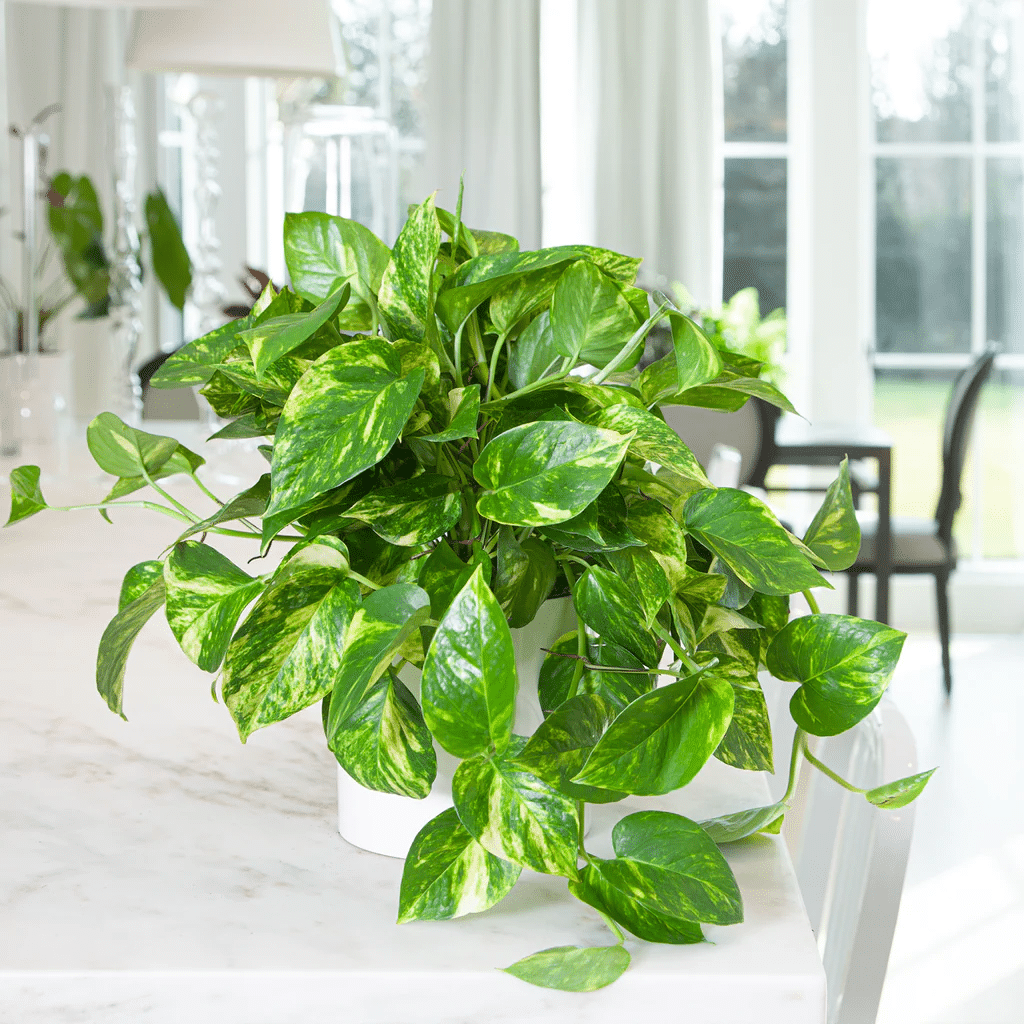
Pothos plants, also known as devil's ivy, are a common houseplant native to the Solomon Islands in the Arum family. Their hardiness and attractive heart-shaped foliage have made them very popular among indoor plant lovers everywhere! They thrive under various lighting conditions, including low light.
Yet when their leaves start changing color from green to yellow or lemon even after pruning off aged parts of the plant that have already changed hues? This is a natural process which allows for new growth since mature pothos tend to turn yellow. If this keeps happening, it may be time to repotting your beloved Devil’s Ivy!
Common Causes of Yellowing Leaves in Pothos

Pothos plants can suffer from yellowing leaves, which is often caused by water-related issues, too much sun exposure or a lack of nutrients. It could also be the result of illnesses and pests. To environmental factors. To help these beautiful plants regain their green foliage once again, here are some potential solutions for each contributing factor.
Water problems such as over-watering or under-watering will lead to discolored foliage on pothos plant species so it's important you adjust your watering technique accordingly. Too little sunlight may cause this issue along with an inadequate amount of necessary minerals – if that’s the case try providing more light.
Watering Issues: Overwatering and Underwatering
Pothos plants can suffer from yellowing leaves if their watering needs are not properly met, either due to overwatering or underwatering. Too much water and soil fungi could cause root rot while depriving the plant of essential nutrients. Insufficient amounts may lead to pale leaves that appear limp with a lack of vital hydration.
To make sure your pothos is getting enough moisture – insert one inch into the dirt then feel for dryness – setting up an appropriate regimen will help prevent these issues arising in the future.
An even schedule should be followed closely when it comes down to looking after all types of plants so they stay healthy at all times!
Sunlight Exposure: Too Much or Too Little
Pothos plants are prone to yellowing leaves, often caused by direct sunlight exposure that is either too much or not enough. Too strong of a light can result in brown spots on the plant's foliage while lack of it may lead to discoloration as well.
To solve this problem, simply move the pothos away from any kind of direct sunlight and position them somewhere with sufficient indirect sun rays instead. This way they will have access to optimal lighting without getting damaged from overexposure. Thus being able to maintain their proper growth indoors for longer periods of time.
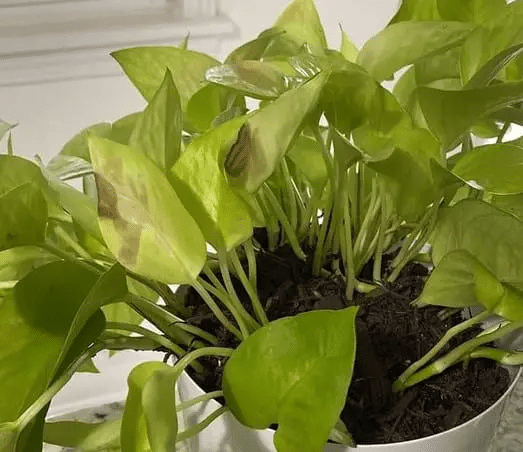
Nutrient Imbalances: Fertilizer Problems
Pothos plants require essential nutrients for their healthy growth and lush green foliage, yet yellowing leaves can be caused by a lack of those vitamins or an overdose in fertilizer.
To fix this issue, it is important to give the plant its needed supplement every three months as well as flush out any extra from the soil or place them into new mediums if too much has been applied. This way, your pothos will obtain what it needs for its flourishing health and energetic foliage.
Diseases and Pests Affecting Pothos

Pothos plants are prone to certain diseases and pests, which can cause the leaves of this plant to become yellow. The most common culprits for discoloration include root rot, bacterial wilt disease, and spider mites.
To help your pothos recover from such conditions and continue growing healthily, it's important that you take action.
In the following paragraphs we will look into these issues in detail so as to understand how best they can be addressed efficiently.
Root Rot: Symptoms and Treatment
Root rot, which can be caused by excessive watering or bad drainage leading to suffocated roots and access to disease-causing pathogens, is a typical sickness of pothos plants. Manifestations of root rot include dark brown and mushy roots as well as yellowing foliage.
To determine if your particular pothos plant has root rot, carefully lift the leaves off its pot while supporting them. Signs would manifest themselves in discolored (brown), soft around the touch roots with an unpleasant smell associated with it.
Given that this condition tends to cause serious damage very quickly should any sort of steps not be taken immediately upon detection, attempting to revive an affected plant may prove difficult without compromising its future growth prospects immensely, thus making disposal needed for a new healthy one most likely eventuality here instead.
A wiser plan then will be prevention: ensuring proper irrigation levels at all times along safe soil drainage methods remain essential when caring for these kinds of greenery species susceptible to destruction from such illnesses like root rots!
Bacterial and Fungal Infections
The yellowing leaves of pothos plants can be a sign of bacterial and fungal infections, such as bacterial leaf spot or the wilt disease caused by Ralstonia solanacearum. Bacterial leaf spot manifests itself with soft, watery spots on the foliage that are then surrounded by yellowness.
To avoid it happening again, watering should target only at soil in order to keep leaves dry. Infected ones should also be removed along with their petioles.

Unfortunately though there is no treatment for Ralstonia solananacearum's wilting thus one must discard completely any plant affected if they want to prevent its spread among other specimens closeby.
Pest Infestations: Spider Mites and Mealybugs
Pothos plants may have their leaves yellowing due to spider mites and mealybugs, small pests that feed on the sap. The former's presence can be identified by silvery dots or stippling with edges around it beginning to turn yellow as well as webs between stems/leaves.
To treat this issue, spraying lukewarm water would help remove them from the plant followed by applying insecticidal soap two times per week for best results.
For mealybug infestations, they appear as white cottony masses on both leaves & stems sucking out all moisture causing a decline in health and yellowness seen throughout its vegetation.
Rubbing alcohol applied onto a swab then cleaning manual is one way, while regularly spraying up through twice weekly intervals with an insecticide remedy are essential ways to keep these irritating bugs at bay!
Environmental Factors Contributing to Yellow Leaves
The environment plays a major role in the well-being of pothos plants, such as through temperature fluctuations and soil quality. To guarantee health for your plant, it is essential to give it an ideal atmosphere with moderate temperatures and decent potting compost.
In this piece we are going to explore how particular environmental elements can influence Pothos Plants while presenting useful remedies that will help keep them healthy all around.
Temperature Fluctuations
Pothos plants can suffer from yellowing leaves due to temperature shifts. To avoid this, you must keep them away from drafts and sudden fluctuations in their environment, as temperatures below 65°F should be avoided for proper growth of these plants.
Water your pothos plant with room-temperature water too. This will assist it in maintaining steady conditions that won't cause stress to the flora.
Soil Quality and Drainage
The health of your pothos plant is highly dependent on the quality and drainage capabilities of its soil. Poor soils can cause yellowing leaves, slower growth rate, stems that are too soft, excessively wet conditions for roots as well as visible root formations.
To better ensure good health outcomes with this type of plant, it's necessary to apply a potting mixture which includes organic components along with perlite or vermiculite in order to achieve an optimal draining effect.
All these measures help reduce potential problems such as soggy ground where serious damage due to root rot could occur.
Plant Maintenance and Care Tips
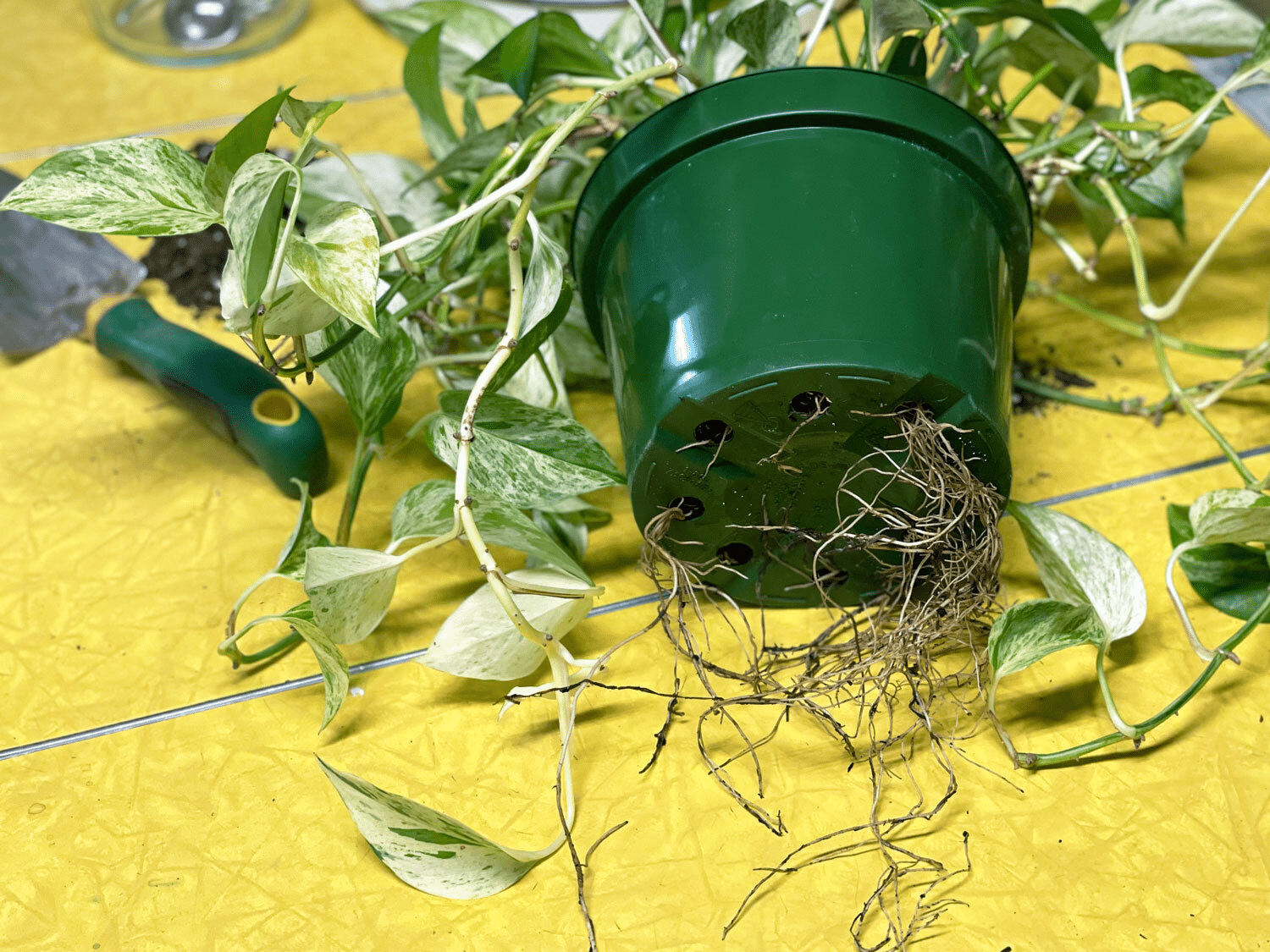
To keep your pothos plant alive and vibrant, providing it with appropriate maintenance is key. Here we'll discuss some suggestions that will help maintain the health of this indoor greenery to prevent yellowing leaves.
Be sure not to over-water. Wait until the soil has dried out before giving your pothos another drink. Water deeply when you do, ensure a thorough soak every time!
Doing so enables optimal hydration for your precious plant without putting too much stress on its system due to excess water accumulation in the soil particles.
Pruning and Repotting
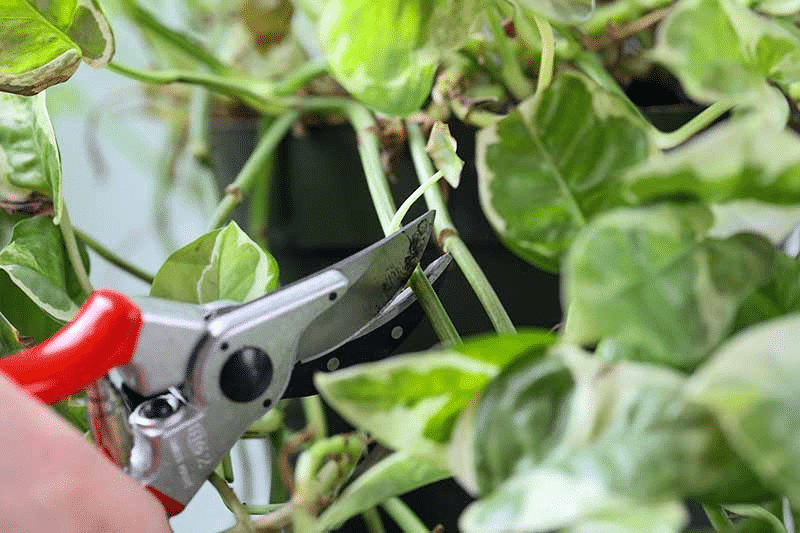
To encourage bushy growth and rid the pothos plant of dead or yellowing leaves, stems, or vines, it is important to prune regularly. This will also ensure that new shoots develop while keeping the overall health of your plant in check.
It's recommended you repot every 18 months to two years as this prevents roots from becoming overgrown and congested when they can be seen protruding out through its drainage hole, providing more room for growth too!
Monitoring Plant Health
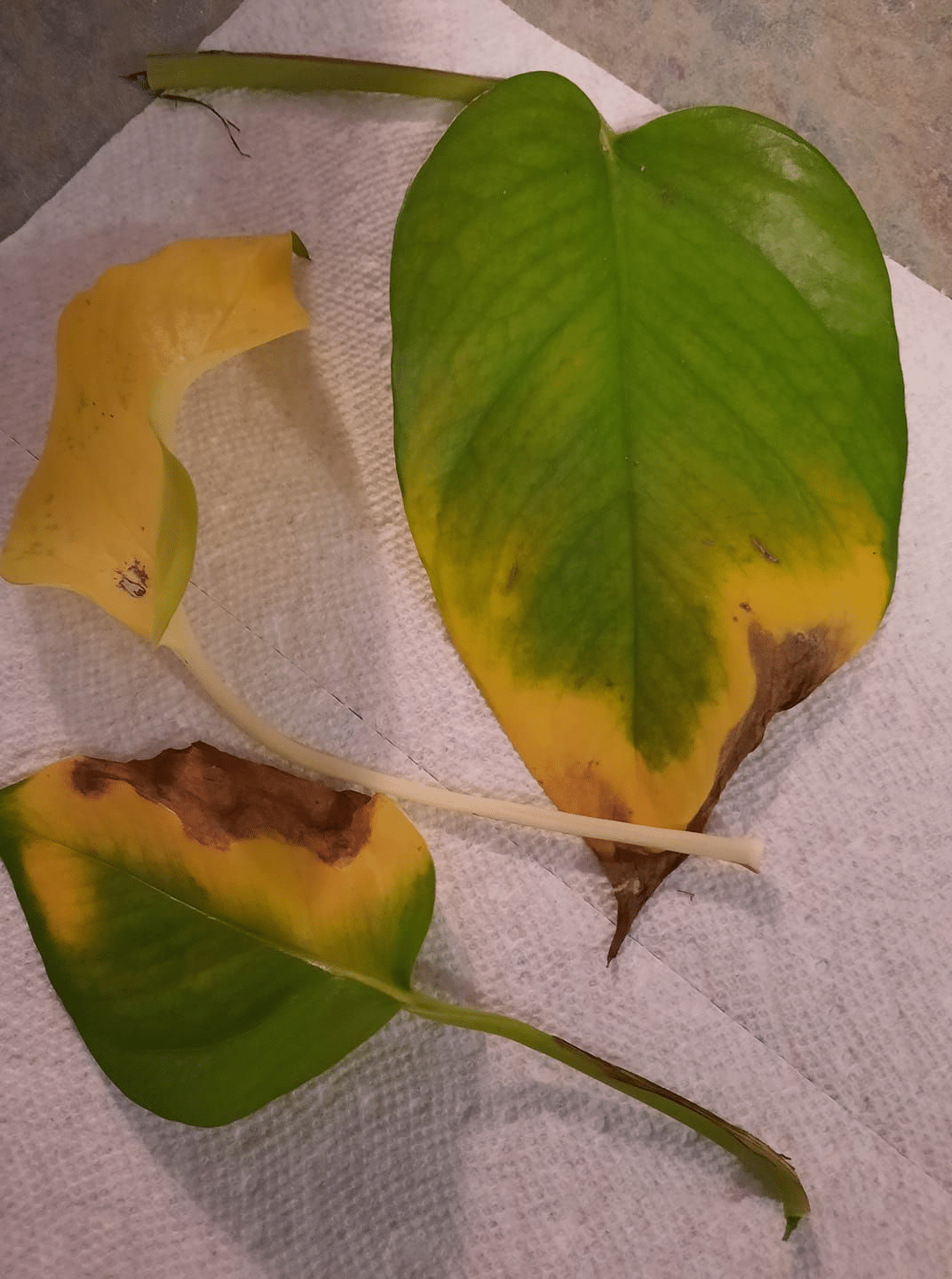
It is important to pay attention to the health of your pothos plant in order to avoid yellowing leaves. Carefully examine its stems and foliage for any wilting or discoloration, as well as check if there are signs of infestations from pests or diseases. Make sure that it has enough moisture in its soil and gets a suitable amount of sunlight daily.
If you spot anything wrong with your pothos such as pale coloring on the leaves or signs of withering. Determine what might be causing these issues then take necessary steps needed to rectify them quickly.
By taking proper care combined with monitoring the wellbeing regularly, keeping a vibrant green Pothos will not be an issue anymore!
Summary
To sum up, pothos plants are a popular choice among houseplants because of their hardy nature and versatility in different kinds of indoor environments. Still, if you notice yellowing leaves appearing on your plant, it could signify an issue that needs addressing.
It is important to be aware of the various potential causes like water imbalance, improper sunlight exposure or environmental conditions as well as pests or diseases so that these problems can be quickly rectified for optimum health and vibrancy from your pothos plant.

By ensuring proper care according to the tips provided here, this will guarantee long-term success with keeping vibrant color tones when nurturing your pothos flowers at home!
Frequently Asked Questions
How do I fix yellow leaves on my pothos?
If you find that your pothos has yellow leaves, it is important to review the care conditions of this plant. Give it a spot with more light and regulate how much water you give it.
Letting the soil dry between each watering should suffice. By adding nutrients or using filtered water for irrigation can help enhance its overall health.
After making some minor modifications in regards to caring for your plants, there should be an improvement and the plants vitality will likely increase within 3 days!
Why is my pothos getting yellow leaves?
The yellow leaves on my pothos are a sign of incorrect soil moisture levels, either being overwatered or drastically underwater can be causes. It's important to regularly check the dryness in the pot by examining if 25% of its top layer is wet, because too much/too little hydration will damage your plant’s foliage.
What does an overwatered pothos look like?
Your pothos may be experiencing overwatering if you find yellow and brown spots on some of its leaves. This is often signified by the foliage exhibiting a discoloration that ranges from light to dark shades of yellowness, with also areas where crispy texture can become visible. Keep an eye out for these signs in order to ensure your plant isn't receiving too much moisture.
Can a yellow pothos leaf turn green again?
The yellow leaves of the yellow pothos plant will not turn green again, as this is a result of chlorosis where there has been a depletion in its chlorophyll. As such, photosynthesis can no longer take place, and since it cannot be revived, it cannot be revived. By the plant itself, newer foliage begins to grow instead.
Yellow pothos leaves thus stay that way permanently due to a lack of their essential pigment – chlorophyll – necessary for turning them back into vibrant shades of greens.





No Comments